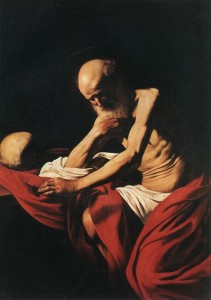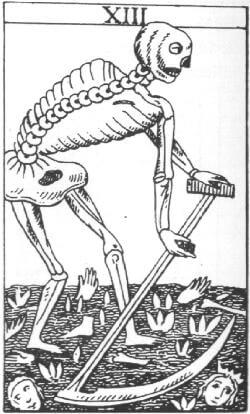A Hieronymus Litany
By Art Beck
I. For the Love of God, Jerome?
Somewhere on the internet—I’m ashamed to say I’ve forgotten where or whose poem it was—I came across a poem that began with a Latin epigraph: Amor ordinem nescit.
 The poem, as I recall, had either a love or soft-core erotic theme, and the epigraph—“love knows nothing of order”—seemed appropriate enough. But the phrase was unattributed and I wondered: was this from Ovid, Catullus, Propertius, maybe even Virgil or Horace? I was surprised when a quick Google query led me to St. Jerome. I might not have been as much taken aback if the quotee were St. Augustine, who famously confessed and dissected his own youthful, untidy love life. But St. Jerome? That desert ascetic and venerable Bible translator?
The poem, as I recall, had either a love or soft-core erotic theme, and the epigraph—“love knows nothing of order”—seemed appropriate enough. But the phrase was unattributed and I wondered: was this from Ovid, Catullus, Propertius, maybe even Virgil or Horace? I was surprised when a quick Google query led me to St. Jerome. I might not have been as much taken aback if the quotee were St. Augustine, who famously confessed and dissected his own youthful, untidy love life. But St. Jerome? That desert ascetic and venerable Bible translator?
Well, I thought, this must be a moralizing, finger-shaking phrase from that old hair-shirt of a Church Father. An admonition against love, not a respectful nod to the power of passion.
Surprisingly, that’s not the case. The phrase comes at the end of Jerome’s “Epistle VII.” Its last lines read: “ … desiderium vestri cogit loqui. Praeproperus sermo; confusa turbatur oratio; amor ordinem nescit.”
Roughly: “ … it’s my longing to be with you that blurts this out in muddled, confused language. Love knows nothing of order.”
As incongruous as these sentiments seem, coming from the old hermit, the object (or rather objects) of his ardor seem odder. Jerome’s letter is jointly addressed to Chromatius, Jovinus, and Eusebius. Old desert companions of Jerome who’d departed the monastic life to make their ecclesiastic way in the cities. All three later became bishops and, at the time of Jerome’s writing, their careers appear already well launched. Chromatius and Eusebius were brothers. And Jovinus was particularly close to both of them, an “adopted brother” of sorts.
Or as Jerome puts it, at the start of the letter (in the Catholic Encyclopedia “New Advent” site translation): “Those whom mutual affection has joined together, a written page ought not to sunder. I must not, therefore, distribute my words some to one and some to another. For so strong is the love that binds you together that affection unites all three of you in a bond no less close than that which naturally connects two of your number. Indeed, if the conditions of writing would only admit of it, I should amalgamate your names and express them under a single symbol. The very letter which I have received from you challenges me in each of you to see all three, and in all three to recognize each.”
The italics are mine, and if this imagery of three-in-one and one-in-three strikes a familiar echo in you as well, I don’t think that’s unintentional. But more about that soon enough.
II. The Pious Trinity
At this historical distance, Jerome’s Epistle VII is pretty dull stuff unless you’re particularly entranced by the early Church Fathers. Much of it fizzles with prosaic pieties, like lukewarm Prosecco too long out of the fridge. And Jerome’s praise of his clerical trio’s various doings seems also tinged with a smirk of righteous careerism.
No more so than when he talks about his newly converted sister, whom he never bothers to name. And whose name, as far as I can tell, may now be lost to history. “You know yourselves how slippery is the path of youth—a path on which I have myself fallen, and which you are now traversing not without fear. She, as she enters upon it, must have the advice and the encouragement of all, she must be aided by frequent letters from you, my reverend brothers. And—for ‘charity endureth all things’—I beg you to get from Pope Valerian a letter to confirm her resolution. A girl’s courage, as you know, is strengthened when she realizes that persons in high place are interested in her.”
III: The Father, a Son, a Holy Ghost … and a Heresy
But Jerome saves the greatest praise of his three inseparable clerics for the letter’s last paragraphs. “For although you confess Christ every day by keeping His commandments, yet to this private glory you have added the public one of an open confession; for it was through you that the poison of the Arian heresy was formerly banished from your city … ”
In Jerome’s time, the late fourth and early fifth century, two competing strains of Christianity skirmished to the edge of armed religious war. Arianism has come down to us as a “heresy” because Jerome’s “orthodox” strain ultimately prevailed. The ideological battle went beyond the bishops and churches, impacting Imperial politics and threatening civil order. From this distance, the core of the dispute seems too esoteric to arouse the level of disruptive passions that it did. It was basically an argument about the nature of what came to be called The Holy Trinity.
The orthodox and ultimately prevailing view was that God the Father, Son, and Holy Ghost were, at once, both distinct and one: equally divine, equally eternal, and “uncreated.” Arians had a slightly different slant. God the Father was “uncreated,” the Son may be equally divine, but He was created by the Father. Why else would Jesus call Him Father? This was an older view more consistent with the Jewish concept of the Messiah, but more and more supplanted by an evolving Roman concept of “Trinitarianism” that was finally enshrined at the Nicean Council in 324, some 23 years before Jerome’s birth.
That didn’t, however, stop a diverse and stubborn Arian anti-establishment from holding to their own, now persecuted, creed. Exiles and book burnings by the orthodox were met with rioting and political machination by the heterodox. The sympathies of successive emperors switched back and forth between the factions, and things didn’t settle down until around 380, when the Emperor Theodosius finally came down firmly in favor of Nicene Trinitarianism.
The Arian view of The Holy Ghost may have been a little less settled—whether or not He preceded The Son seemed a matter of open discussion. But, in both orthodox Trinitarianism and Arianism, The Holy Ghost was most often portrayed as the bond of love between the “blood-relative” Father and Son.
Jerome, who lived to be 73, is usually portrayed and imagined as a white-bearded scholar, pontificating and translating the Hebrew Bible into Latin in his unadorned cell. But his Epistle VII was written in 374, when he was only some 27 years old. And given the heated anti-Arian ecclesiastic politics of the time, it’s hard not to read a certain youthful, near-sacrilegious badinage into his letter’s opening and closing lines.
To wit, it seems impossible to not hear definite echoes of the Holy Trinity in Jerome’s “three in one” characterization of his colleagues. And to not wonder, what’s going on here? Some sort of tongue-in-cheek-among-clerics imagery? Then later, wonder again, when directly following the paragraph in which he praises the illustrious trio for banishing the poisonous Arian heretics, Jerome ends his letter: “You are surprised perhaps at my thus making a fresh beginning quite at the close of my letter. But what am I to do? I cannot refuse expression to my feelings. The brief limits of a letter compel me to be silent; my affection for you urges me to speak. I write in haste, my language is confused and ill-arranged; but love knows nothing of order.”
In effect, at least as I read the sanctified Jerome, he’s saying that his enthusiasm over the exile of the Arians, logically and rhetorically, really belonged at the letter’s beginning where he, playfully, evoked the Trinitarian metaphor to describe his three addressees. So to my lapsed-Catholic, secular eyes, Epistle VII seems not so much the judicious letter of a “Doctor of the Church,” but the consciously literary missive of a young partisan who loves his team to distraction because they stomped the other guys. I adore you, my “Trinity Team,” you rock!
IV: Jerome the Ciceronian
Some ten years later, in his Epistle XXII, Jerome looked back on his more youthful self and recorded a spiritual crisis: “Many years ago, when for the kingdom of heaven’s sake I had cut myself off from home, parents, sister, relations, and—harder still—from the dainty food to which I had been accustomed … I still could not bring myself to forgo the library which I had formed for myself … with great care and toil. And so, miserable man that I was, I would fast only that I might afterward read Cicero. After many nights spent in vigil, after floods of tears called from my inmost heart, after the recollection of my past sins, I would once more take up Plautus. And when at times I returned to my right mind, and began to read the prophets, their style seemed rude and repellant … ”
In the midst of this conflicted period, “about the middle of Lent,” the saint-to-be fell gravely ill with a fever. So ill that “preparations for my funeral” were made. It was then he had an often noted dream in which “suddenly I was caught up in the spirit and dragged before the judgment seat … and here the light was so bright … I … did not dare to look up. Asked who and what I was, I replied I am a Christian. But He who presided said: Thou liest, you are a follower of Cicero and not of Christ.”
In that fever dream, Jesus ordered Jerome to be scourged, and the whipping went on until the “bystanders falling down before the knees of Him who presided” begged pity because of the miscreant’s youth. After a stern lecture, Jerome found himself awake, “returned to the upper world … Drenched in tears … shoulders black and blue,” with real bruises that lasted “long after I awoke from my sleep.”
I’ve sometimes idly wondered just what characterized a “Ciceronian.” Perhaps Jerome’s, ten years younger, playful Trinitarian parody is a good example? At least of Jerome subordinating Divinity to the service of literature. A long Latin tradition. If not particularly Ciceronian, certainly Ovidian.
V. But What a Waste of a Great Line
Jerome’s Epistle VII is prose, and awfully prosaic in parts. But it shares an aspect of many good poems: its last lines double back, implicit in its opening lines. Still, some 1600 years later, you have to ask: is Jerome’s snide, inside-Catholic joke really worthy of his resplendently resonant ending sentence, “Amor ordinem nescit”?
For me, that plaintive statement cries out in the wilderness (as Jerome literally did in his hermit youth), an orphan begging for the poem it should belong to. Except as history, no one cares about the Arian/Trinitarian controversy anymore, and “loving” one side or another is about as exciting as being swept up in passion for the Guelfs or the Ghibellines. Conversely, when Catullus or Ovid or Dante talk about love, we take it personally, it endures. Even St. Paul’s 1st Corinthian agape seems to reverberate from a place more primal than theological. But here, all we have is Jerome’s sublime last line—looking in vain for its poem.
Amor ordinem nescit deserves more than utilization as a toss-off epigraph in someone’s poem. It deserves, I think, something like the kind of Protean renderings it would get if it were a line of Catullus, translated and mutated, over and over through generations by successive poets who can’t help playing with their own variations. I think Jerome’s unorderly amor should have its own heretical litany, a poem of its own, maybe something like this for a start:
Amor ordinem nescit
Love is disorderly.
Love’s a disorder.
Love takes no orders.
Love orders you around.
Love is sloppy. When you’re
in love, you’re a mess.
And what a lovely mess it is,
when love messes the bed.
Love and anarchy play by
their own silly rules: Who arrives
last wins, and who comes again
smiles knocking over all
the pieces. Love has zilch
to do with the well ordered mind,
but loves the sweet complicity
of chaos. The only undeniable
constant here is unbelievably
wilful, hopeless love …
Translated excerpts from Jerome’s Epistles are from the Catholic Encyclopedia “New Advent” site. http://www.newadvent.org/fathers/3001.htm.
About the Author
 Art Beck has published several collections of poetry and poetry translations, most recently Luxorius Opera Omnia, a Duet for Sitar and Trombone (Otis College, Seismicity Editions), which was awarded the 2013 Northern California Book award for poetry in translation. His poetry and essays have appeared in a wide range of literary journals, including Alaska Quarterly, Artful Dodge, OR, Sequoia, Translation Review, and in anthologies such as Heyday Books’s California Poetry from the Gold Rush to the Present and Painted Bride Quarterly’s 20-year retrospective. He was also a regular contributor to Rattle‘s since-discontinued e-issues with a regular series on translating poetry.
Art Beck has published several collections of poetry and poetry translations, most recently Luxorius Opera Omnia, a Duet for Sitar and Trombone (Otis College, Seismicity Editions), which was awarded the 2013 Northern California Book award for poetry in translation. His poetry and essays have appeared in a wide range of literary journals, including Alaska Quarterly, Artful Dodge, OR, Sequoia, Translation Review, and in anthologies such as Heyday Books’s California Poetry from the Gold Rush to the Present and Painted Bride Quarterly’s 20-year retrospective. He was also a regular contributor to Rattle‘s since-discontinued e-issues with a regular series on translating poetry.


